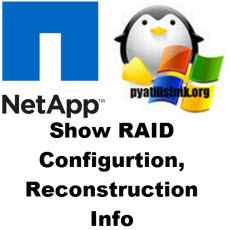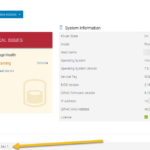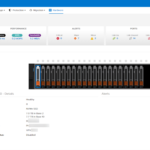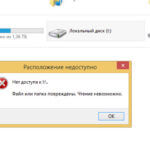Netapp Show RAID Configurtion, Reconstruction Info
 Good day! Dear readers and guests of one of the major blogs on system administration Pyatilistnik.org. Last time I told you how to configure a Mikrotik router in a small office. Today we will talk about: Netapp Show RAID Configuration, reconstruction information. This command displays Netapp RAID setup and rebuild status and other information such as spare disks. I am sure that there will be colleagues who are faced with such a task for the first time and he has a number of questions.
Good day! Dear readers and guests of one of the major blogs on system administration Pyatilistnik.org. Last time I told you how to configure a Mikrotik router in a small office. Today we will talk about: Netapp Show RAID Configuration, reconstruction information. This command displays Netapp RAID setup and rebuild status and other information such as spare disks. I am sure that there will be colleagues who are faced with such a task for the first time and he has a number of questions.
Why is RAID-DP needed?
As mentioned earlier, the traditional "single-parity RAID" (RAID types 3, 4, and 5) offers satisfactory protection against one disk failure, it may be a complete failure of one the entire disk, or read error, the so-called "bit error". In both cases the read data is restored using data redundancy on surviving data disks, plus disk “checksums”, parity. If the failure is an error read, then reconstructing the data is almost an instant procedure, and a disk array or volume data remains available. However, if the problem is the entire disk failure, when all the data, stored on it, lost, all this data will need to be restored, and the disk array or the volume remains in a degraded mode for a long time as long as the data The lost drive will not be reconstructed entirely to the backup drive. Exactly the existence of degraded mode during RAID data reconstruction shows that the classic single-parity RAID and its data protection capabilities today do not satisfy the increased data protection requirements on modern drives
How modern high-capacity drives work in RAID
Modern drives continue to evolve, like other computer technologies. Hard disks are orders of magnitude larger than at the time the RAID technology came in. Despite, that hard drives are becoming larger, their reliability does not grow in proportion to their increase capacity, and, even more importantly, the level of so-called “bit errors” of the disk, increases in proportion to the increase in their capacity. These three factors are increased capacity. single disc, not improving in proportion to the growth of their capacity reliability, and the increasing level of bit errors on large volumes of modern disks - all this leads to serious discrepancy for classic RAID with parity structures with using one parity disk, user-requested data protection level at drives. Since hard drives fail today, as they did when the RAID technology was introduced, these technologies are as demanded today as they were then.
When a single drive fails, RAID recreates lost data due to redundancy of information on the remaining disks and data checksum on the parity disk, and writes it to the disk from the reserve, the so-called spare disk. However, since the time RAID first appeared, the increased disk capacity has been greatly extended the RAID reconstruction process. At the same rotation speed, the time required at recovery of lost data stored on a 2TB disk is much more than for a disk of 600GB or less. Difficulties with increased reconstruction time are compounded by and the fact that SATA drives are increasingly used for storing data only slower in the process of reading and writing data, but also somewhat less reliable, than FC or SAS drives
RAID data protection with one parity disk on large disks
There are various ways to improve the data protection situation on a RAID scheme with one parity disk, as disk capacity grows, but they are all not without flaws. First option is to continue to buy and use disks in storage systems minimally available capacity on the market, which will save shorter recovery time after a failure. However, such a trip is not practical from any point of view. Storage density is critical important value in any data center, and the use of disks of smaller capacity leads to decrease in storage per square meter of data center area, and rise in price storage system operation. In addition, storage manufacturers are forced to use those drive models that manufacturers are ready to supply them with in sufficient quantities, that is, the most massive in production, and small capacity drives can often be just unavailable in the right quantities.
The second way to use large capacity drives in a traditional single-parity RAID is a little more practical, but with the advent of double-parity RAID and, in particular, RAID-DP, it is also unattractive for several reasons. This is a way to make RAID groups from a relatively small number of such large drives, which reduces RAID reconstruction time. Continuing the analogy with how large drives volume require more time for RAID reconstruction than smaller ones disks, and a RAID array consisting of a large number of disks is restored after a failure longer than consisting of a smaller number of them. However, RAID from a small number of drives has significant drawback: in the case of RAID groups from a small number of disks, an overhead for controller and usable space decreases.
The most reliable protection before the dual parity scheme was RAID 1, or "Mirroring". In RAID 1, the disk mirroring process replicated an exact copy all data on disk to another disk. Although RAID 1 provided the highest possible for that moment the level of data protection from disk error, the cost of its use was high, since it took twice as much disk space to store the same amount data. As noted earlier, using smaller RAID groups for providing improved resiliency, leads to an increase in the cost of ownership, as reduces usable capacity by invested dollar. From this point of view, RAID 1 with its unpleasant requirements to double the capacity of the array to store the same amount of data, is the most expensive fault-tolerant storage solution with the highest cost of ownership.
Data Protection Using RAID-DP
Soon, with widespread adoption in the large-capacity disk storage industry, creating significant problems for the protection of data stored on them, users and analysts began to need a new solution for improved reliability of storage on disk arrays. To meet these requirements, NetApp has released a new type of solution. RAID, called RAID-DP. RAID-DP stands for RAID with Double Parity, and significantly increased fault tolerance in case of disk failure or read errors, compared to traditional single-parity RAID. If we take all the relevant indicators of the typical operating time for failure for disks, calculate them according to the formula for RAID-DP, and compare the results with traditional single-parity RAID, then you will see that RAID-DP is thousands of times more reliable, on the same most drives. With this level of reliability, RAID-DP is even more fault tolerant. RAID 10, but for the price of RAID 4. RAID-DP offers businesses the best value ownership, without the need to risk data retention for this result
Netapp Display RAID configuration
Enter the following command to show the RAID config:
1
| |
Displays the RAID configuration (disk groups, disks, information about the running processes on disks (rebuild, reset, etc.), disk status (spare/parity/dparity)). The output should look similar to:
1 2 3 4 5 6 7 8 9 10 11 12 13 14 15 16 17 18 19 20 21 22 23 24 25 26 27 28 | |






